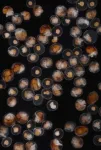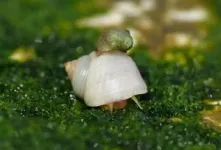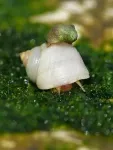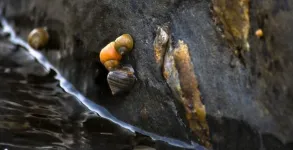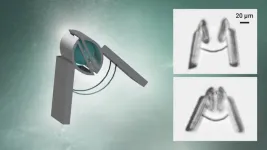(Press-News.org) The egg did come first. Egg-laying arose deep in evolutionary time, long before animals even made their way onto land. Throughout evolution, there have been many independent transitions to live-bearing across the animal kingdom, including insects, fish, reptiles, and mammals. Yet, these examples have taught us very little about the number of genetic changes it takes to go from eggs to live offspring.
Now, an international team of researchers led by ISTA postdoc Sean Stankowski has used a humble marine snail to reveal the genetic changes that underpin the transition to live-bearing. The main advantage of investigating this phenomenon in marine snails: Live-bearing evolved within the past 100,000 years in these organisms—a blink of an eye in evolutionary terms. Thus, these marine snails could provide a unique chance to reveal the genetic basis of live-bearing. “Almost all mammals give live birth, and this function has accompanied their evolution for around 140 million years. Yet, in this study, we can investigate how live-bearing evolved completely independently, and much more recently, in marine snails,” says Stankowski. The team’s central finding: the switch to live-bearing is caused by around 50 genetic changes that are scattered around the snail genome.
One species, over a hundred names
The seaside marine snail Littorina saxatilis is the most misidentified creature in the world, The Guardian reported in 2015. Over centuries, scientists have described it as a new species or subspecies more than a hundred times, despite it being commonly found throughout the North Atlantic shores. This whole confusion must have stemmed from this species’ many shell variations and habitats. On top of this, L. saxatilis has a unique reproductive mode: it has evolved live-bearing while related marine snails that share its habitat lay eggs. “Scientists have mainly studied shell variation within L. saxatilis rather than what differentiates the species from its egg-laying relatives. The reality is that this snail species is the odd one out when it comes to its breeding strategy,” says Stankowski.
Losing the egg, one step at a time
An eye-opening moment was when Stankowski inferred the phylogenetic tree, or evolutionary “family tree”, of L. saxatilis and other related, egg-laying Littorina species, using whole-genome sequences. He showed that, although live-bearing is the only trait that distinguishes L. saxatilis from its egg-laying relatives, L. saxatilis did not seem to form a single evolutionary group. It was this mismatch between reproductive strategy and ancestry that ultimately allowed Stankowski and his collaborators to disentangle the genetic basis of live-bearing from other genetic changes throughout the snail genome. “We were able to identify 50 genomic regions that together seem to determine whether individuals lay eggs or give birth to live young,” says Stankowski. “We don’t know exactly what each region does, but we were able to link many of them to reproductive differences by comparing patterns of gene expression in egg-laying and live-bearing snails.” Overall, the results suggest that live-bearing evolved gradually through the accumulation of many mutations that arose over the last 100,000 years.
The costs and benefits of live-bearing
The research shows that the switch to live-bearing allowed snails to spread into new areas and habitats where egg-layers cannot survive and reproduce. But the precise benefits of live-bearing in these snails remain a mystery. “We don’t know for sure, but the transition from egg-laying to live-bearing may have arisen by natural selection favoring increased egg retention time, with the eggs eventually hatching inside the mother. We speculate that eggs might have been more susceptible to drying out, physical damage, and predators,” says Stankowski. In live-bearers, offspring are protected from the elements until they can fend for themselves, he adds. But by solving one problem, live-bearing would have certainly created others. “The extra investment in offspring would have almost certainly placed new demands on the snails’ anatomy, physiology, and immune system. It’s likely that many of the genomic regions we identified are involved in responding to these types of challenges”.
Mapping the function of each gene
Although the work sheds new light on the transition from eggs to live offspring, many questions remain to be answered. “Most genetic innovations are in fact really old and tangled up on an evolutionary scale which makes it difficult to study their origin,” says Stankowski. “These snails have allowed us to do exactly that, but we have only begun to scratch the surface of what they can teach us about the origins of novelty.” As a next step, the researchers want to map the function of each mutation. “We aim to understand how each genetic change shaped the snails’ form and function on the way to live-bearing, step by step,” concludes Stankowski.
Sean Stankowski is a postdoctoral fellow in Nicholas Barton’s group at the Institute of Science and Technology Austria (ISTA). He initiated this project at the University of Sheffield, UK, and led a team of collaborators at ISTA, the University of Sheffield, and the University of Gothenburg, Sweden, among others.
END
The snail or the egg?
How marine snails switched from laying eggs to giving birth
2024-01-04
ELSE PRESS RELEASES FROM THIS DATE:
Human histories shape the global biodiversity data used to make future decisions
2024-01-04
Global biodiversity data used to make major policy and conservation investment decisions reflect legacies of social and political inequities. In a Policy Forum, Melissa Chapman and colleagues highlight this issue and its implications for global conservation policy and planning. The rapid rise of global biodiversity data repositories like the Global Biodiversity Information Facility (GBIF) – a data repository that synthesizes billions of species observations across the globe – has led to unprecedented insight into large-scale biodiversity patterns worldwide. Not only are ...
Studies reveal the evolutionary origin of unique traits in pitcher plants and marine snails
2024-01-04
In a pair of studies, researchers use different approaches to investigate how complex and innovative phenotypic traits evolve in plants and animals. “The amazing breadth of plant and animal diversity across the globe has evolved by circuitous paths, and resolving the complex history of genomes and traits unlocks new depths for understanding evolution,” writes Kathryn Elmer in a related Perspective. Although biological traits are constantly changing in populations, the emergence of a trait ...
Anti-CTLA-4 nanobodies promote antitumor immunity without inducing colitis in mice
2024-01-04
Microbiota-reactive T cells trigger colitis in mice harboring the microbiota of wild-caught mice following CTLA-4 blockade, according to a new study that reveals a major mechanism by which anti-CTLA-4 antibodies induce inflammatory toxicities during antitumor immune checkpoint inhibitor therapies. The findings could advance the development of next-generation CTLA-4 inhibitors that promote antitumor immune responses without triggering intestinal disease. Cancer immunotherapies with immune checkpoint inhibitors are widely used to promote antitumor immune responses in a range of human cancers. However, they can also lead to inflammatory ...
Editorial: Genuine images in 2024
2024-01-04
In an Editorial, Science Journals’ Editor-in-Chief, Holden Thorp, outlines changes to the publication’s editorial policies and practices for 2024, including plans to adopt the use of Proofig – an artificial intelligence-powered image-analysis tool – to detect altered images across all six of the Science family journals. Proofig is a tool that screens images for duplication and other types of manipulations. Although Science has been conducting “human-eye” image checks on some papers, the new tool will enhance Science’s review process and reduce ...
Biologists uncover the secrets of evolutionary change
2024-01-04
**Strictly embargoed until 19:00 GMT on Thursday 4 January 2024**
Biologists uncover the secrets of evolutionary change
Images available here
Big evolutionary changes happen gradually and not in giant leaps, a team of biologists led by the University of Sheffield have discovered
Using new methodology to study an evolutionary shift in the birthing style of marine snails, experts have been able to answer the long-debated question as to how game-changing innovations like flight, vision, and the bearing of live offspring happened
Understanding the evolutionary origin of these developments is important because ...
Does self-checkout impact grocery store loyalty?
2024-01-04
In an effort to reduce costs and improve customer satisfaction, retailers have implemented self-checkouts in stores across the country. They have become increasingly popular, but some brands like Walmart are removing self-checkouts in some locations while adding more in others. There are many advantages and disadvantages of self-checkout for both the customer and the retailer, but little formal research has investigated the impact of self-checkout on customers’ shopping experience. This led researchers from Drexel University’s LeBow College of Business to look at how self-checkout systems in grocery stores influence customer loyalty ...
Nanoparticle transport across the blood brain barrier increases with Alzheimer’s and age, study finds
2024-01-04
Neurodegenerative disorders such as Alzheimer’s disease affect more than 270 million people worldwide. AD is the leading cause of dementia, resulting in memory loss due to atrophy of neurons in the hippocampus, which is the part of the brain that regulates learning and memory. Nanoparticles designed to carry drugs have emerged as a strategy for treating different diseases, but in the context of neurodegenerative disease, much of the research has focused on developing strategies for getting nanoparticles across the blood brain barrier and into targeted regions of the brain.
In a new study, an interdisciplinary team of researchers at the University of Illinois Urbana-Champaign ...
Recent advances in medical applications of nanoparticles
2024-01-04
Nanoparticles have become an essential part of medicine, from aiding in diagnostic tests to serving as immunotherapy agents and more. Thanks to their ultrasmall size — around the thickness of a strand of DNA — these particles are adept at getting inside tissues and targeting precise areas. Here are three recent papers published in ACS journals that could expand the beneficial uses for nanoparticles, based on results in rats. The technology could be used to improve contraceptive methods, burn creams and arthritis ...
A high-tech research clinic on wheels
2024-01-04
Hispanic/Latina women with a history of hypertensive disorders of pregnancy (HDP) – conditions marked by high blood pressure during pregnancy – are more likely to have abnormalities in their heart structure and function decades later when compared with women without a history of HDP, according to a National Institutes of Health-supported study. The findings, published in the journal Hypertension, also suggest that while having high blood pressure later in life can contribute to these abnormalities, HDP play the greater role, significantly raising a woman’s risk of developing cardiovascular disease.
“The ...
Springs aboard – gently feeling the way to grasp the microcosmos
2024-01-04
These “picosprings” have remarkably large and tuneable compliancy and can be controlled remotely through magnetic fields (even deep within the human body) allowing articulated motion in microrobots as well as micromanipulations well beyond the state of the art.
Moreover, the extension of the picosprings can also be used visually to measure forces, for example propulsion or grasping forces, in interaction with other objects like cells. For example, these picosprings have been used to measure the locomotive propulsion force of sperm cells. The publication showcases these capabilities by demonstrating several ...
LAST 30 PRESS RELEASES:
National poll: Less than half of parents say swearing is never OK for kids
Decades of suffering: Long-term mental health outcomes of Kurdish chemical gas attacks
Interactional dynamics of self-assessment and advice in peer reflection on microteaching
When aging affects the young: Revealing the weight of caregiving on teenagers
Can Canada’s health systems handle increased demand during FIFA World Cup?
Autistic and non-autistic faces may “speak a different language” when expressing emotion
No clear evidence that cannabis-based medicines relieve chronic nerve pain
Pioneering second-order nonlinear vibrational nanoscopy for interfacial molecular systems beyond the diffraction limit
Bottleneck in hydrogen distribution jeopardises billions in clean energy
Lung cancer death rates among women in Europe are finally levelling off
Scientists trace microplastics in fertilizer from fields to the beach
The Lancet Obstetrics, Gynecology, & Women’s Health: Taking paracetamol during pregnancy does not increase risk of autism, ADHD or intellectual disabilities, confirms new gold-standard evidence review
Taking paracetamol during pregnancy does not increase risk of autism, ADHD or intellectual disabilities
Harm reduction vending machines in New York State expand access to overdose treatment and drug test strips, UB studies confirm
University of Phoenix releases white paper on Credit for Prior Learning as a catalyst for internal mobility and retention
Canada losing track of salmon health as climate and industrial threats mount
Molecular sieve-confined Pt-FeOx catalysts achieve highly efficient reversible hydrogen cycle of methylcyclohexane-toluene
Investment in farm productivity tools key to reducing greenhouse gas
New review highlights electrochemical pathways to recover uranium from wastewater and seawater
Hidden pollutants in shale gas development raise environmental concerns, new review finds
Discarded cigarette butts transformed into high performance energy storage materials
Researchers highlight role of alternative RNA splicing in schizophrenia
NTU Singapore scientists find new way to disarm antibiotic-resistant bacteria and restore healing in chronic wounds
Research suggests nationwide racial bias in media reporting on gun violence
Revealing the cell’s nanocourier at work
Health impacts of nursing home staffing
Public views about opioid overdose and people with opioid use disorder
Age-related changes in sperm DNA may play a role in autism risk
Ambitious model fails to explain near-death experiences, experts say
Multifaceted effects of inward foreign direct investment on new venture creation
[Press-News.org] The snail or the egg?How marine snails switched from laying eggs to giving birth
